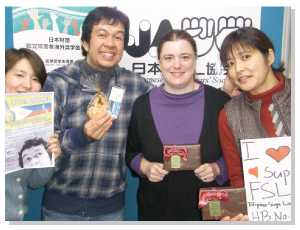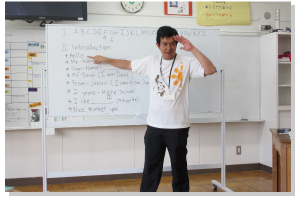- HOME
- Alumni News
- Raymond J. Manding (14th trainee)
- Raymond's Final Report
Raymond's Final Report
Diversity in Deaf Society
Introduction
I am from Bohol, the Philippines. I am a Filipino Deaf. I belong to two Deaf organizations in the Philippines: the Philippine Federation of the Deaf Youth Section, where I am a board member for Visayas; and the Deaf Boholanos Society, where I am an adviser. I was selected as one of the trainees for the 14th Duskin Leadership training program in Japan. I had applied for the 12th Duskin Leadership Training in 2011-2012 but my application was not accepted. Arriving in Japan for the first time, I was excited to see the new place and meet new people during my 10-month stay. I met the people from the Duskin AINOWA Foundation, JSRPD staff members and the other trainees from six different Asia-Pacific countries. We all became good friends and became part of the Duskin Family.
Studying Japanese for 3 months
For the first three months, I studied the Japanese language and Japanese Sign Language (JSL). Japanese language was more difficult than JSL, because JSL is the part of my visual language and I can communicate better through hand movements. However, I continued to get familiar with the Japanese language. I really appreciated my Japanese language and JSL teachers who taught me.
Japanese Culture: Home-Stay in the New Year
In the New Year, I had a great experience through the home-stay program. I went to Wakayama Prefecture and met the Fujioka Family. The husband and wife were both Deaf and they had two hearing boys in their home. The Deaf mother cooked traditional Japanese foods for the New Year while I saw her cooking and telling Deaf father funny stories. And their two kids always played with me. They rode on my shoulders and we played together with their toys such as a railway set. Fun! I also experienced how to use traditional Japanese costume called Kimono and going to a temple to pray with the Fujioka family. I really had an enjoyable time with them. They also seemed appreciating good moments with me.
First Encounters in the Winter Season
I saw snow for the first time in Japan. I had never seen it in the Philippines. In Niigata Prefecture, I learned how to ski with my instructors. I fell a lot of times but I had so much fun! It was my memorable first winter in Japan.
Training Objectives in Japan
- Research and analysis of sign language, creation of new words and Deaf Culture
- Deaf Education: Bilingual and Bicultural
- Project management in Deaf Organization
- Management of the Deaf Youth
Individual Trainings in Japan
Community
Social Welfare Centers
I had my individual training for two months in Hyogo Prefecture. I learned that there are five Deaf Social Welfare centers in Hyogo – located in Kobe, Amagasaki, Awaji, Himeji and Toyooka – and some of them are run by the Hyogo Association of the Deaf. These centers support lives of the Deaf by ensuring communication through sign language. At these centers it is also possible to receive healthcare support, trainings, creative activities and consultations & advice.
However, what is very important is to have UNITY through the Deaf community. I was inspired with Deaf people when they shared with me everything about their life as Deaf. In the Philippines, we do not have Deaf social welfare centers and things are very difficult for the Filipino Deaf. I think that we need a welfare center just like the ones in Japan. And I will help my organization, Deaf Boholanos Society, to provide opportunities for my fellow Deaf Boholanos, and also to have different activities such as workshop and other events.
Information
I learned about Deaf information services when I went to the Deaf Information center in Hyogo. It provides information services in case of emergencies or disasters. It also offers consultation & training, sign language interpretation, captioning and other services. It is important to provide welfare and information for the Filipino Deaf community. I think that this information/accessibility issues need to be addressed in the Philippines because there is always a lack of information for Deaf people during disasters, and this is associated with lack of sign language interpreters. This information and accessibility issue for Deaf people and also persons with other kinds of disability in the Philippines should be supported so that they will also be prepared as well. This is a chance to provide them with good knowledge and accessibility.
Youth Section
I had some surprising new learnings about how to manage youths from the Japanese Federation of the Deaf Youth Section (JFDYS). They have organizational flowcharts showing that as many as 43 Prefectures in Japan have Deaf youth organizations. I strongly wish my Deaf youth organization in the Philippines will someday have a group network across different provinces just like the ones appearing in the JFDYS organizational flowcharts. I had many new learning from the meetings, workshops and other activities when I attended different activities in the Deaf youth in Hyogo Prefecture, Shiga Prefecture, the Kinki region, Hiroshima Prefecture and Hokkaido Prefecture. This Deaf youth’s goals are friendship (unity), training and accessibility for the youth section. I truly believe that our Deaf youth will know the importance of UNITY across Deaf communities in the world. And we also need Deaf youth leadership in the future to support young Deaf people in times of need. After the training, I will return to the Philippines and then I will help Philippine Federation of the Deaf Youth Section.

Language
Sign Language: Communication Stages & Dialects (in different Hometowns)
After many new lessons about sign language I learned about communication stages. People use different sign languages depending on age group. There are also different sign language levels such as those different by age; children, teenagers and senior citizens; and by their own natural dialects from different hometowns. I learned about research on sign languages on the videos shown by Mr. Osugi, a member of the Deaf faculty of National Tsukuba University of Technology (NTUT). He taught me how to do research on sign languages. I realized when I met two Deaf people living in Tokyo and Wakayama Prefecture, that they have different dialects – for example, they had a different sign for ‘water.’ I also received training at Meisei Gakuen School for the Deaf, which is the only Deaf school that has bilingual and bicultural education in Japan. I was told by one of the Deaf faculty members of the school that a Deaf child (0~3 years old) can communicate through sign language. For example, the Deaf child meant to sign ‘Mother’ but it was actually ‘Father’ (thumb up on face). After growing up, the child will be able to sign ‘MOTHER’ well. It was really interesting for me to research how each word differed between different dialects. I wish Filipino sign language include the curriculum/system in Philippine Deaf Education.
Deaf Education: Bilingual & Bicultural
I was really interested in studying bilingual and bicultural Deaf education. I was on the training program at Meisei Gakuen School for the Deaf for two weeks. This school is the only private bilingual/bicultural school for the Deaf in Japan. How I would like to organize biculturalism for the Deaf is – first the focus will be on Deaf culture, and second, a country’s culture such as Japanese culture can be taught, thus it can include a little bit about the hearing culture. As for Bilingual Education, sign language (country’s own language) must come first and second, both writing and reading skills for Deaf children need to be taught. Having this can support the two cultures and two languages and thereby children and people in the Deaf community will have good knowledge, and importantly, they can become better communicators through sign language – this is what I wish for the Deaf school in the Philippines in the future. I would like to study and research Deaf education with a bilingual lens in the Philippines someday.
Deaf Documentary
Deaf Documentary films are based on facts about real people, places and events. From predecessors’ personal history, we can learn how education, language, culture and community have developed for the Deaf. I also learned about newspapers, magazines, documentary films and information services for the Deaf in Japan when I was training at the Deaf information and training center . I think that Deaf documentary should also be explored it in the Philippines.
Special Training
At the Japanese ASL Signers Society (JASS), I had training on presentation skills for Japanese audiences for two weeks with Ms. Kumiko, who acted as my instructor. My presentation skills were then practiced through the video. I would like to thank Ms. Kumiko and JASS staff for giving me an opportunity for this training.


A Moment of Spring
I saw spring for the first time in Japan and the most beautiful of it all were the cherry blossoms which I had never seen before in the Philippines. I went to see many beautiful cherry trees in Kyoto and Osaka Prefectures and I just loved it. For me spring is the best moment of my life in Japan with all the cherry blossoms.
Post-training in Japan and my goals for Deaf society in the Philippines
- Support and help with the needs of the Deaf community in the Philippines
- The Deaf Boholanos Society: I will help them rebuild the DBS organizational activities and teach about Deaf Society and Awareness.
- Philippine Federation of the Deaf Youth Section: I will help them to implement some new organizational management skills and activities. I have decided to run for President for the PFDYS in 2015.
- Research on sign language in the Philippines’ communication stages
- Master’s Degree in Deaf Education with bilingual viewpoint
Conclusion
In the 10 months, I learned about the Deaf society in Japan. I also learned a lot from my colleagues, as they shared their experiences of Japanese Deaf and disability communities – I really appreciated them. I am willing to contribute to helping the Deaf community in the Philippines and also I really believe our community needs to be better organized providing more opportunities and expanding the knowledge and awareness in my homeland.
Words of Appreciation
I would like to thank so much to everyone; the Duskin AINOWA Foundation for giving me the wonderful opportunity and for supporting everything in Japan; the Japanese Society for Rehabilitation of Persons with Disabilities (JSRPD) for truly helping me with everything; the Hyogo Association of the Deaf in Hyogo Prefecture, including the towns of Kobe, Amagasaki, Awaji, Himeji and Toyooka; the Deaf-Blind society and some other societies whose support throughout the trainings I truly appreciate; National Tsukuba University of Technology for the Deaf (NTUT); the Japanese ASL Signers Society (JASS); Meisei Gakuen School for the Deaf for giving me the chance to have an opportunity in this training; my instructors who gave me opportunities to learn in this training; my Duskin trainee Family who are happy together and helping each other; and my Japanese friends whom I truly appreciate for spending time with me.
Once again, I would like to say “thank you” from the bottom of my heart. God bless and more power to each and every one.




